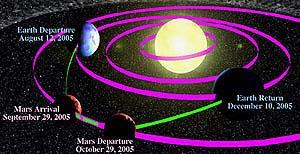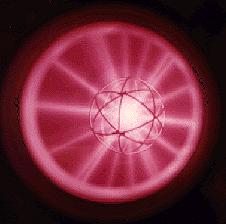|
In this article we examine
the use of antimatter and fusion to propel future spacecraft to
the stars. Along the way exploring the possibilities for both the
production of antimatter, and also its use in conjunction with other
technologies.
by Dave Dooling
Antimatter is one of the most attractive
words in science fiction literature and nearly as good a topic at
parties as black holes. It might also be the fuel that powers spaceships
to the planets and perhaps the stars.
"Antimatter has tremendous energy
density," said Dr. George Schmidt, chief of propulsion research
and technology at NASA. Matter-antimatter annihilation - the complete
conversion of matter into energy - releases the most energy per
unit mass of any known reaction in physics.
The popular belief is that an antimatter
particle coming in contact with its matter counterpart yields energy.
That's true for electrons and positrons (anti-electrons). They'll
produce gamma rays at 511,000 electron volts.
But heavier particles like protons
and anti-protons are somewhat messier, making gamma rays and leaving
a spray of secondary particles that eventually decay into neutrinos
and low-energy gamma rays.
And that is partly what Schmidt and
others want in an antimatter engine. The gamma rays from a perfect
reaction would escape immediately, unless the ship had thick shielding,
and serve no purpose. But the charged debris from a proton/anti-proton
annihilation can push a ship.
"We want to get as close as possible
to the initial annihilation event," Schmidt explained. What's important
is intercepting some of the pions and other charged particles that
are produced and using the energy to produce thrust."

Pennsylvania State University
Mars in 6 weeks?
And back in a total of four months? That's the prediction
of a design team working on antimatter rocket concepts at
Pennsylvania State University. But first, you have to get
the stuff - and store it.
|
This is not your father's starship
He's not going to use it the
way that the Starship Enterprise did, creating a warp field to move
the vessel across space faster than the speed of light. At its most
basic level, an antimatter rocket is still a Newtonian rocket moving
a space probe through action and reaction.
And what a reaction. Where the Space
Shuttle Main Engine has a specific impulse, a measure of efficiency,
of 455 seconds, and nuclear fission could reach 10,000 seconds,
fusion could provide 60,000 to 100,000 seconds, and matter/antimatter
annihilation up to 100,000 to 1,000,000 seconds.
But first: Where do you get it? And
how do you store the nuclear equivalent of the universal solvent?
Antiprotons, explained Dr. Gerald Smith
of Pennsylvania State University, can be obtained in modest quantities
from high-energy accelerators slamming particles into solid targets.
The antiprotons are then collected and held in a magnetic bottle.
While that's been done easily enough
in small quantities, fueling a rocket will take much more.
"We're building a Penning trap," Smith
said, "one that will be lightweight and robust." When completed,
it will weigh about 100 kg (220 lbs), much of it liquid nitrogen
and helium to keep about a trillion antiprotons - far less than
a nanogram - quiescent in a zone about 1 mm (1/25th inch) across.
"How do you know that you have particles
in the trap?" Smith asked. "They're odourless and colourless." However,
they do have distinctive radio frequency signatures which Smith
and his colleagues have been able to measure. They've also demonstrated
that their trap design would hold a significant quantity for up
to 5 days.
"Our aim is to get up to a microgram
of antiprotons," Smith said. "There are some interesting propulsion
technologies that work at that level. We think we can do it."
A trillion antiprotons is the maximum
that can be stored under those conditions. More could be held if
they were turned into anti-hydrogen, antiprotons plus positrons.
A lot of bang for the buck
Right now, antimatter is the most expensive substance on Earth,
about $62.5 trillion a gram ($1.75 quadrillion an ounce). The production
is, at best, 50 percent efficient because half of what's created
are regular protons, and the equipment now used was not designed
to fuel rockets. Harold Gerrish of NASA and others estimate that
improvements in equipment to slow and trap the antiprotons could
bring the price down to about $5,000 per microgram. A new injector
at Fermilab outside Chicago will allow that facility to increase
its production tenfold, from 1.5 to 15 nanograms a year.
Lab. for Energetic Particle Science
|
A schematic
of the heart of a Penning trap where a cloud of antiprotons
(the fuzzy bluish spot) is kept cold and quiet by liquid
nitrogen and helium and a stable magnetic field.
|
|
|
"Right now, a lot of antiprotons are
produced, but most are wasted," Gerrish said.
CERN has now produced anti-hydrogen
as part of the Athena fundamental physics program to determine if
antimatter indeed is indistinguishable from matter. Using the same
Ioffe-Pritchard trap developed at CERN, Dr. Steven Howe of Synergistic
Technologies in Los Alamos, N.M, expects that large quantities of
anti-hydrogen atoms could be stored safely for long periods. At
low temperatures, the wavelength of the atom is several times that
of the material making up the container walls, so the atoms are
reflected with little effort.
"Our goal is to remove antimatter from
the far-out realms of science fiction into the commercially exploitable
realm for transportation and medical applications."
Beyond the Enterprise - Fusion Power
A step back from antimatter is fusion, the power source of the future
for the last five decades. Controlled fusion - joining two lightweight
nuclei to get a slightly heavier nucleus and a lot of energy - has
been challenging. In their quest to exceed Q=1, the break-even point,
scientists have moved from low energy yields of Q=0.0000000000001
in the late 1950s to Q=0.3 today, and developed a large body of
engineering and scientific knowledge showing that it can be made
practical.
"From the NASA perspective, the challenge
is to adapt fusion for space propulsion," said Dr. Francis Thio,
a principal research scientist in the Propulsion Research Centre.
"Magnetised Target Fusion is one of the major approaches that we
are studying." NASA/Marshall is working with Los Alamos National
Laboratory and the Air Force Research Laboratory to adapt MTF for
propulsion.
"MTF tries to operate in an intermediate
regime between the conventional magnetic fusion, and inertial confinement
using a laser," Thio explained. The problem with conventional magnetic
confinement is it operates at very low density. To achieve sufficient
power, the fusion reactor must be large, which translates to a high
cost.
On the other hand, inertial confinement
fusion uses a tiny plasma, 1,000 trillion times denser than in a
magnetic confinement scheme. But that requires a driver - usually
banks of intense, short-pulse lasers - that heat and compress the
target in a short time. That also drives the cost up.
"MTF tries to operate at not too low
or too high a density," Thio explained, "and achieve a reasonable
rate of fusion activity with a density 10,000 to 100,000 times higher
than magnetic confinement, and 10,000 to 100,000 times lower than
laser fusion."
It's more economical and uses pulse-power
drivers - powerful capacitor banks that drive electromagnetic implosion
- that are available today at low cost. It does not have the implosion
speed generated by a laser beam, but a magnetic field confines the
target plasma and insulates the inertial wall that implodes to cause
the fusion.
Can I get the compact model?
Even if fusion is achieved, current methods are too cumbersome
to use in rockets.
"The mass is quite prohibitive," said
Professor T. Kammash of the University of Michigan. "We want to
make the physics work without using very large magnets." The mirror
magnets for a fusion rocket would weigh about 401 tonnes (metric
tons), about 16 times a single Space Shuttle payload. The heat radiators
would add 240 tonnes.
Kammash's students are experimenting
with a droplet radiator design that, using liquid lithium as a coolant,
could reduce the radiator mass to 57 tonnes.
A rotating magnetic field could induce
a magnetic field and electrical currents, "a clever way of fooling
the plasma" into behaving as if it was in a conventional magnetic
mirror system.
In turn, the mass of the spacecraft
would come down from 720 to 230 tonnes, and the 44-metre (144-ft)
long engine would have a specific impulse of 130,000 seconds.
"It's quite impressive," Kammash said.

Peering into
the heart of a star. What looks like a 1950s model of an atom
is a hollow cathode with a tiny plasma cloud contained inside
an IEC fusion chamber small enough to sit atop a lab bench.
(UIUC)
|
One of the most intriguing possibilities
raised actually dates back to the 1950s and a concept developed
by Philo Farnsworth, who pioneered most of the fundamental technologies
for television in the 1920s and '30s.
"This is a really neat concept, something
you can literally put your hands around," said Dr. Jon Nadler of
NPL Associates, who is working with the University of Illinois Urbana-Champaign
to develop the idea that Farnsworth had in 1950: fusion in a small
bottle.
"You can use the power [it would generate]
to power electric propulsion, or use the plasma for thrust," Nadler
explained.
A star in a bottle
The technique is called inertial electrostatic confinement (IEC),
a technique that avoids the use of massive magnets and laser systems
used in other fusion-power techniques. Instead, the IEC device uses
a hollow cathode, and the natural charges of electrons and ions,
to form virtual electrodes that confine ions in a spherical region
at the centre of the 61 cm (2 ft) diameter IEC vacuum chamber.
While true antimatter and true fusion
propulsion will remain the "rockets of the future" for some time,
a hybrid of the two might work in the near term.
"It's a good short cut," Schmidt said
of antimatter-catalyzed fusion. In this approach, a small quantity
of antiprotons is beamed into a fusion target. The resulting matter-antimatter
annihilation heats a target enough to cause thermonuclear fusion.
Because of the energies and expense
involved in producing antimatter, this method is not practical for
power production on Earth. Overall, it is a net energy loser. Like
all other forms of rocket propulsion, it's a sort of battery in
which energy is expended to provide a large quantity in a tiny space,
available on demand.
But, it could yield a rocket with a
specific impulse of 13,500 to 67,000 seconds (30-147 times better
than the Shuttle Main Engine), depending on the scheme used.
"Fusion missions would need just micrograms
to reach the Oort cloud," the deep freeze of comets beyond the orbit
of Pluto, Gerrish said. The antimatter load would cost about $60
million. But reaching the stars would require metric tons.
So a journey to the stars using antimatter
alone may remain the stuff of books for just a little while to come.
|
